3D Printing Assisted Injection Molding of Chemically Plated W-Cu Composite
Abstract
:1. Introduction
2. Experimental Method
2.1. Materials
2.2. Experimental
2.3. Material Characterizations
3. Results and Discussion
3.1. Phase Composition and Microstructure
3.2. Effect of Sintering Temperature on the Microstructure of Alloys
3.3. Effect of Sintering Time on the Microstructure of Alloys
3.4. Influence of Process Parameters on Final Cinder Properties
3.5. Discussion and Optimization of Low Densities
4. Conclusions and Vision for the Future
Author Contributions
Funding
Institutional Review Board Statement
Informed Consent Statement
Data Availability Statement
Conflicts of Interest
Abbreviations
| Abbreviations | Full Name |
| LDPE | Low Density Polyethylene |
| PW | Paraffin Wax |
| EVA | Ethylene Vinyl Acetate |
| SA | Stearic Acid |
| BHT | P-cresol |
| DTD | Vinyl Sulphate |
| XRD | X-Ray Diffraction |
| SEM | Search Engine Marketing |
References
- Ding, F.; Fan, J.; Cao, L.; Wang, Q.; Li, J.; Li, P. Effect of microstructure refinement on surface morphology and dynamic mechanical properties of W-Cu alloys. Materials 2021, 14, 4615. [Google Scholar] [CrossRef]
- Gai, Y.; Tang, F.; Hou, C.; Lu, H.; Song, X. First-Principles Calculation on the Influence of Alloying Elements on Interfacial Features of W-Cu System. Acta Met. Sin. 2020, 56, 1036–1046. [Google Scholar] [CrossRef]
- Hu, W.; Li, Y.; Zhang, W.; Ma, Z.; Feng, Y.; Liu, C.; Li, C.; Yu, L.; Liu, Y. Excellent mechanical, thermal and electrical properties of ultrafine W-Cu alloys via freeze-drying technology. Scr. Mater. 2024, 239, 115805. [Google Scholar] [CrossRef]
- Wang, Y.; Zhuo, L.; Yin, E. Progress, challenges and potentials trends of tungsten-copper(WCu) composite/pseudo-alloys: Fabrication, regulation and application. Int. J. Refract. Met. Hard Mater. 2021, 100, 105648. [Google Scholar] [CrossRef]
- Zhang, H.; Liu, J.-R.; Li, Z.-B.; Deng, X.-C.; Zhang, G.-H.; Chou, K.-C. Preparation and properties of Al2O3 dispersed fine-grained W-Cu alloy. Adv. Powder Technol. 2022, 33, 103523. [Google Scholar] [CrossRef]
- Zhang, H.; Liu, J.-R.; Zhang, G.-H. Preparation and properties of W-30 wt% Cu alloy with the additions of Ni and Fe elements. J. Alloys Compd. 2022, 928, 167040. [Google Scholar] [CrossRef]
- Zhang, H.; Deng, X.-C.; Zhang, G.-H. Preparation and properties of multiphase solid-solution strengthened high-performance W–Cu alloys through alloying with Mo, Fe and Ni. Mater. Sci. Eng. A 2023, 871, 144909. [Google Scholar] [CrossRef]
- Wu, Z.-Q.; Zhao, W.; Gao, K.; Du, S.-H.; Kong, Q.-Q.; Sun, D.-J.; Gao, Y. Influence of sintering time on microstructure and properties of hot oscillatory pressing sintered W–Cu refractory alloys. Tungsten 2024, 6, 323–332. [Google Scholar] [CrossRef]
- Cheng, J.; Lei, C.; Xiong, E.; Jiang, Y.; Xia, Y. Preparation and characterization of W–Cu nanopowders by a homogeneous precipitation process. J. Alloys Compd. 2006, 421, 146–150. [Google Scholar] [CrossRef]
- Luo, L.-M.; Ding, X.-P.; Xu, W.-Z.; Wang, C.-Y.; Qin, Y.-Q.; Wu, Y.-C. Strengthening mechanisms and research progress in the W/Cu interfaces. Int. J. Refract. Met. Hard Mater. 2024, 125, 106900. [Google Scholar] [CrossRef]
- Luo, L.-M.; Ding, X.-P.; Xu, W.-Z.; Wang, C.-Y.; Qin, Y.-Q.; Wu, Y.-C. Direct Alloying of Immiscible Tungsten and Copper Based on Nano Active Structure and Its Thermodynamic Mechanism. Acta Met. Sin. 2022, 59, 679–692. [Google Scholar] [CrossRef]
- Chen, W.; Shi, Y.; Dong, L.; Wang, L.; Li, H.; Fu, Y. Infiltration sintering of WCu alloys from copper-coated tungsten composite powders for superior mechanical properties and arc-ablation resistance. J. Alloys Compd. 2017, 728, 196–205. [Google Scholar] [CrossRef]
- Hamidi, A.G.; Arabi, H.; Rastegari, S. Tungsten–copper composite production by activated sintering and infiltration. Int. J. Refract. Met. Hard Mater. 2011, 29, 538–541. [Google Scholar] [CrossRef]
- Liu, D.; Meng, L.; Zou, J.; Luo, L.; Wu, Y. Microstructure and properties of silver-added W-Cu prepared by infiltration sintering. Int. J. Refract. Met. Hard Mater. 2022, 108, 105947. [Google Scholar] [CrossRef]
- El-Hadek, M.A.; Kaytbay, S.H. Fracture properties of SPS tungsten copper powder composite. Metall. Mater. Trans. A 2013, 44, 544–551. [Google Scholar] [CrossRef]
- Wang, Z.; Li, X.; Zhu, J.; Mo, F.; Zhao, C.; Wang, L. Dynamic consolidation of W–Cu nanocomposite from W–CuO powder mixture. Mater. Sci. Eng. A 2010, 527, 6098–6101. [Google Scholar] [CrossRef]
- Hu, W.; Dong, Z.; Yu, L.; Ma, Z.; Liu, Y. Synthesis of W-Y2O3 alloys by freeze-drying and subsequent low temperature sintering: Microstructure refinement and second phase particles regulation. J. Mater. Sci. Technol. 2020, 36, 84–90. [Google Scholar] [CrossRef]
- Hu, W.; Dong, Z.; Ma, Z.; Liu, Y. Microstructure refinement in W–Y2O3 alloys via an improved hydrothermal synthesis method and low temperature sintering. Inorg. Chem. Front. 2020, 7, 659–666. [Google Scholar] [CrossRef]
- Yang, W.; Zhou, L.; Peng, K.; Zhu, J.; Wan, L. Effect of tungsten addition on thermal conductivity of graphite/copper composite. Compos. Part B Eng. 2013, 55, 1–4. [Google Scholar] [CrossRef]
- Qiu, W.; Pang, Y.; Xiao, Z.; Li, Z. Preparation of W-Cu alloy with high density and ultrafine grains by mechanical alloying and high pressure sintering. Int. J. Refract. Met. Hard Mater. 2016, 61, 91–97. [Google Scholar] [CrossRef]
- Gao, K.; Liu, D.; Ma, T.; Zhao, J.; Sun, D.; Gao, Y.; Pan, K. Oscillating pressure sintered W-Cu refractory alloy with high density and hardness under lower temperature. Int. J. Refract. Met. Hard Mater. 2022, 102, 105702. [Google Scholar] [CrossRef]
- Li, X.; Hu, P.; Wang, J.; Chen, S.; Zhou, W. In situ synthesis of core-shell W-Cu nanopowders for fabricating full-densified and fine-grained alloys with dramaticall improved performance. J. Alloys Compd. 2021, 85, 156958. [Google Scholar] [CrossRef]
- Han, T.; Hou, C.; Zhao, Z.; Huang, X.; Tang, F.; Li, Y.; Song, X. W–Cu composite with excellent comprehensive properties. Compos. Part B Eng. 2022, 233, 109664. [Google Scholar] [CrossRef]
- Guo, Y.; Guo, H.; Gao, B.; Wang, X.; Hu, Y.; Shi, Z. Rapid consolidation of ultrafine grained W-30 wt.% Cu composite by field assisted sintering from the sol-gel prepared nano-powders. J. Alloys Compd. 2017, 724, 155–162. [Google Scholar] [CrossRef]
- Meng, Y.; Shen, Y.; Chen, C.; Li, Y.; Feng, X. Effects of Cu content and mechanical alloying parameters on the preparation of W–Cu composite coatings on copper substrate. J. Alloys Compd. 2014, 585, 368–375. [Google Scholar] [CrossRef]
- Luo, L.-M.; Tan, X.-Y.; Lu, Z.-L.; Zhu, X.-Y.; Zan, X.; Luo, G.-N.; Wu, Y.-C. Sintering behavior of W–30Cu composite powder prepared by electroless plating. Int. J. Refract. Met. Hard Mater. 2014, 42, 51–56. [Google Scholar] [CrossRef]
- Dong, L.L.; Ahangarkani, M.; Chen, W.G.; Zhang, Y.S. Recent progress in development of W-Cu composite: Fabrication, modification and applications. Int. J. Refract. Met. Hard Mater. 2018, 75, 30–42. [Google Scholar] [CrossRef]
- Shanaghi, A.; Amiri, A.; Kazazi, M.; Souri, A.R.; Moradi, H.; Jaffari, A. Effects of processing parameters on phase, morphology, mechanical and corrosion properties of W–Cu nanocomposite powder prepared by electroless copper plating. Appl. Phys. A 2020, 126, 601. [Google Scholar] [CrossRef]
- Lebedev, M.; Promakhov, V.; Schulz, N.; Vorozhtsov, A.; Lerner, M. Effects of Sintering Temperature on the Microstructure and Properties of a W-Cu Pseudo-Alloy. Metals 2023, 13, 1741. [Google Scholar] [CrossRef]
- Meng, Y.; Shen, Y.; Chen, C.; Li, Y.; Feng, X. Microstructures and formation mechanism of W–Cu composite coatings on copper substrate prepared by mechanical alloying method. Appl. Surf. Sci. 2013, 282, 757–764. [Google Scholar] [CrossRef]
- Huang, L.-M.; Luo, L.-M.; Ding, X.-Y.; Luo, G.-N.; Zan, X.; Cheng, J.-G.; Wu, Y.-C. Effects of simplified pretreatment process on the morphology of W–Cu composite powder prepared by electroless plating and its sintering characterization. Powder Technol. 2014, 258, 216–221. [Google Scholar] [CrossRef]
- Li, X.; Zhang, M.; Zhang, G.; Wei, S.; Xu, L.; Zhou, Y. Effect of spark plasma sintering temperature on structure and performance characteristics of Cu-20wt% W composite. J. Alloys Compd. 2022, 912, 165246. [Google Scholar] [CrossRef]
- Zhou, H.; Feng, K.; Luan, B. Process Parameter Optimization and Improved Properties of Large Electric Current-Sintered Mo-W-Cu Alloys Using Orthogonal Analysis. JOM 2024, 76, 1284–1293. [Google Scholar] [CrossRef]
- Niu, B.; Liu, Q.; Liu, L.; Ni, J.; Ren, R.; Li, Q.; Luo, N.; He, J. Influence of powder ball milling pretreatment on microstructure and properties of Mo-W-Cu refractory functional alloys sintered in a normal-pressure hydrogen atmosphere. Powder Technol. 2024, 438, 119625. [Google Scholar] [CrossRef]
- Zhang, D.; Xiang, S.; Liang, Y.; Li, T.; Tang, C.; Yin, X.; Zhang, X.; Ma, X. Ultrafast fabrication of W/Cu composite using flash sintering. Mater. Chem. Phys. 2024, 321, 129501. [Google Scholar] [CrossRef]
- Liu, Y.; Feng, K.; Zhou, H.; Chen, S. Microstructure and phases investigations of W–Mo–Cu alloy prepared by large current electric field sintering. Intermetallics 2022, 143, 107488. [Google Scholar] [CrossRef]
- Lu, W.; Chen, X.; Ho, D.C.W.; Wang, H. Thermodynamic mechanism of phase formation for W-Mo-Cu composite by electric field sintering. Int. J. Refract. Met. Hard Mater. 2022, 109, 105986. [Google Scholar] [CrossRef]
- Sutrisna, C.C. Role of Cu-Containing MEA Binder and Sintering Temperatures on Synthesis and Characteristics of Tungsten-Based Alloys. Met. Mater. Int. 2023, 29, 1739–1749. [Google Scholar] [CrossRef]
- Abu-Oqail, A.; Ghanim, M.; El-Sheikh, M.; El-Nikhaily, A. Effects of processing parameters of tungsten–copper composite. Int. J. Refract. Met. Hard Mater. 2012, 35, 207–212. [Google Scholar] [CrossRef]
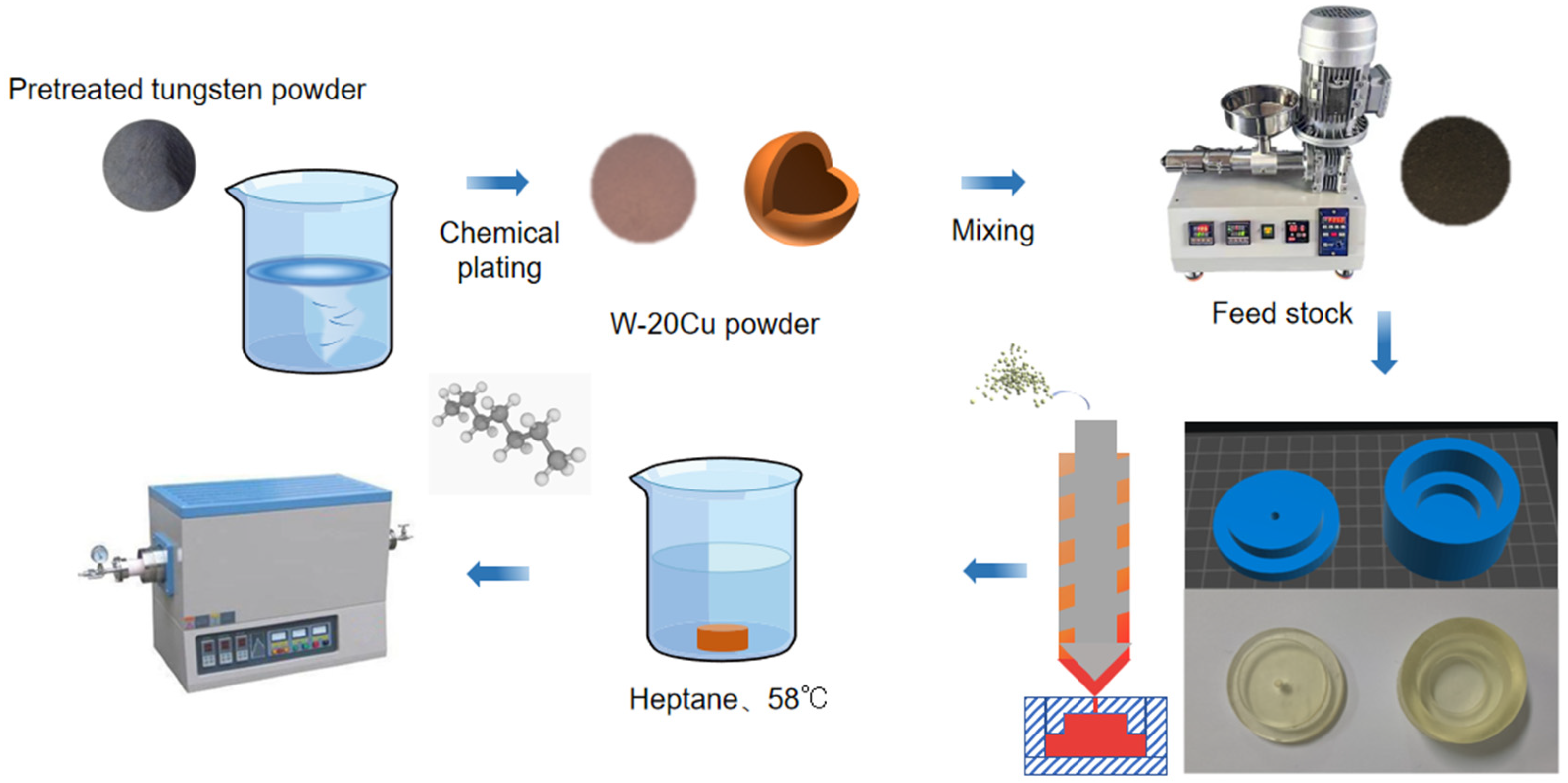
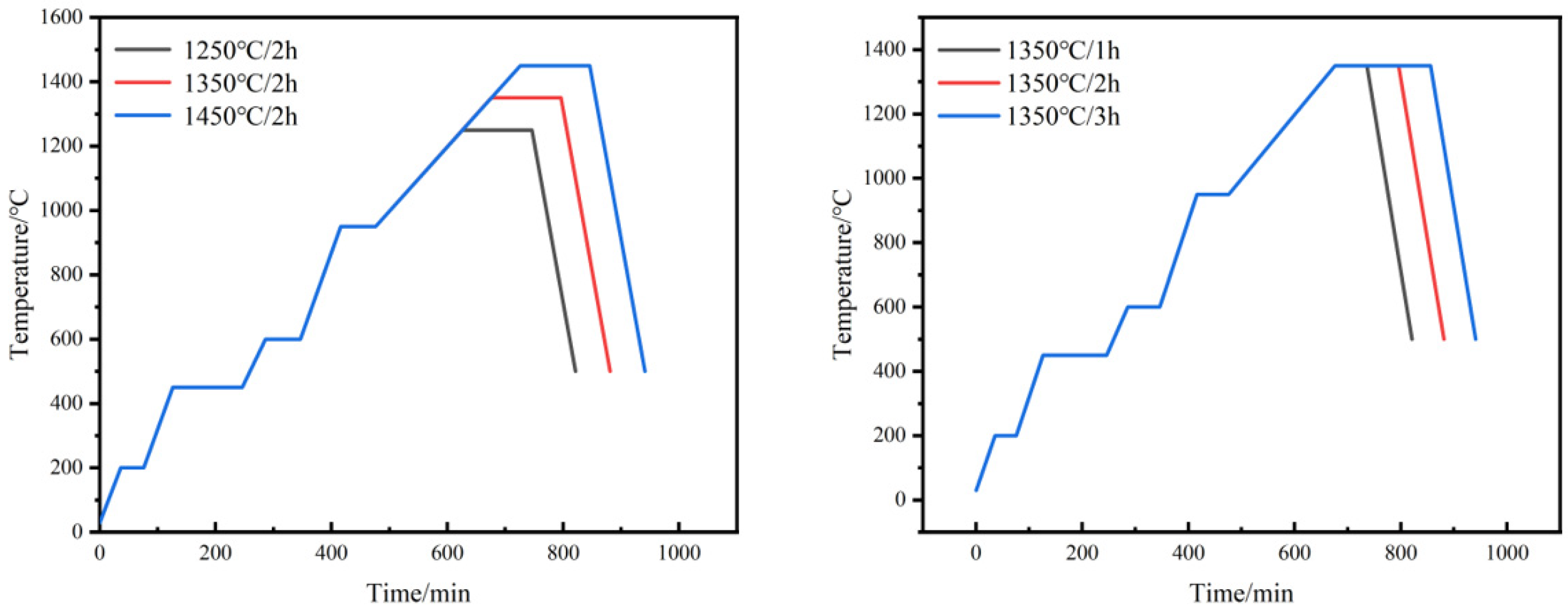
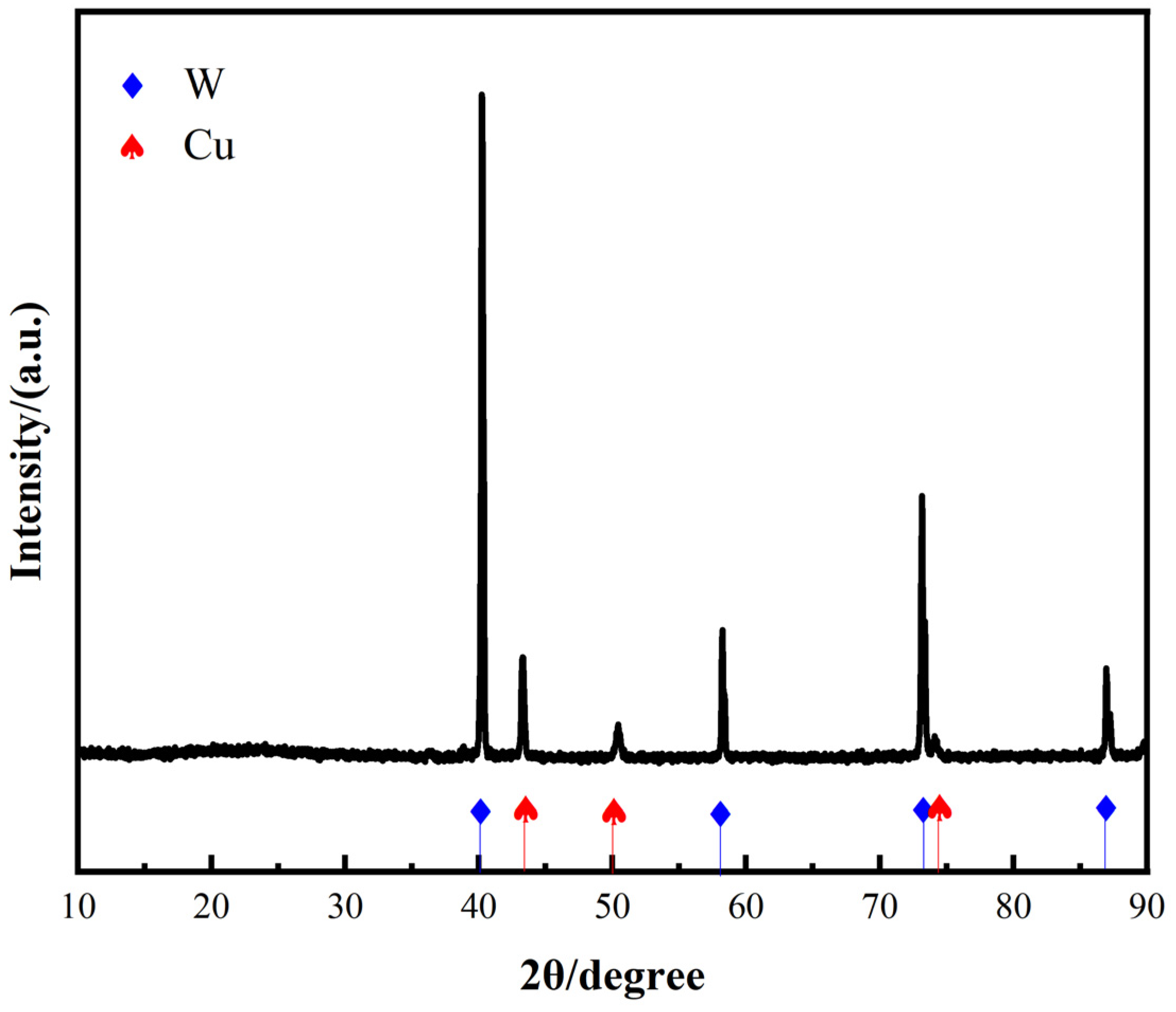
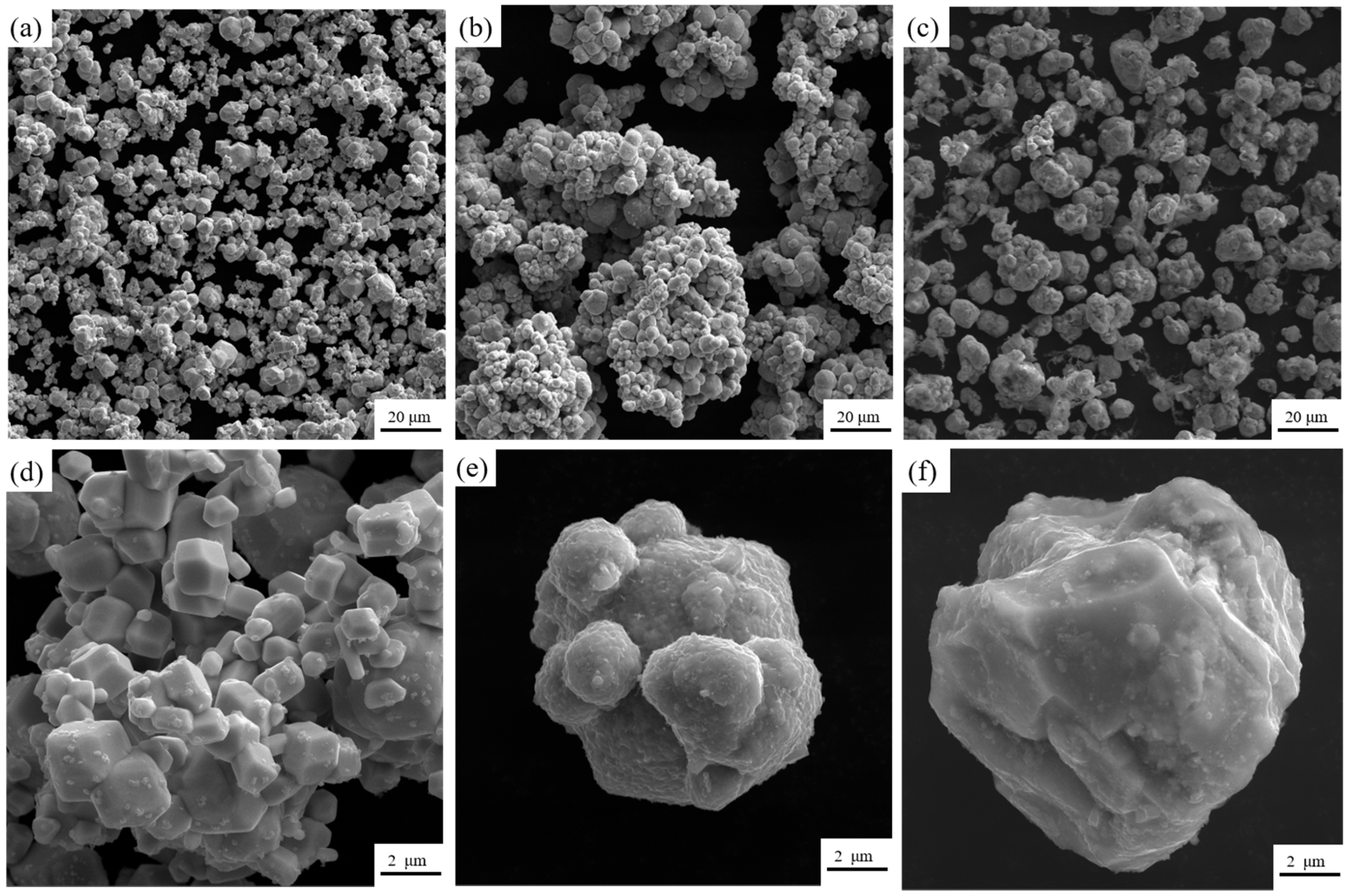
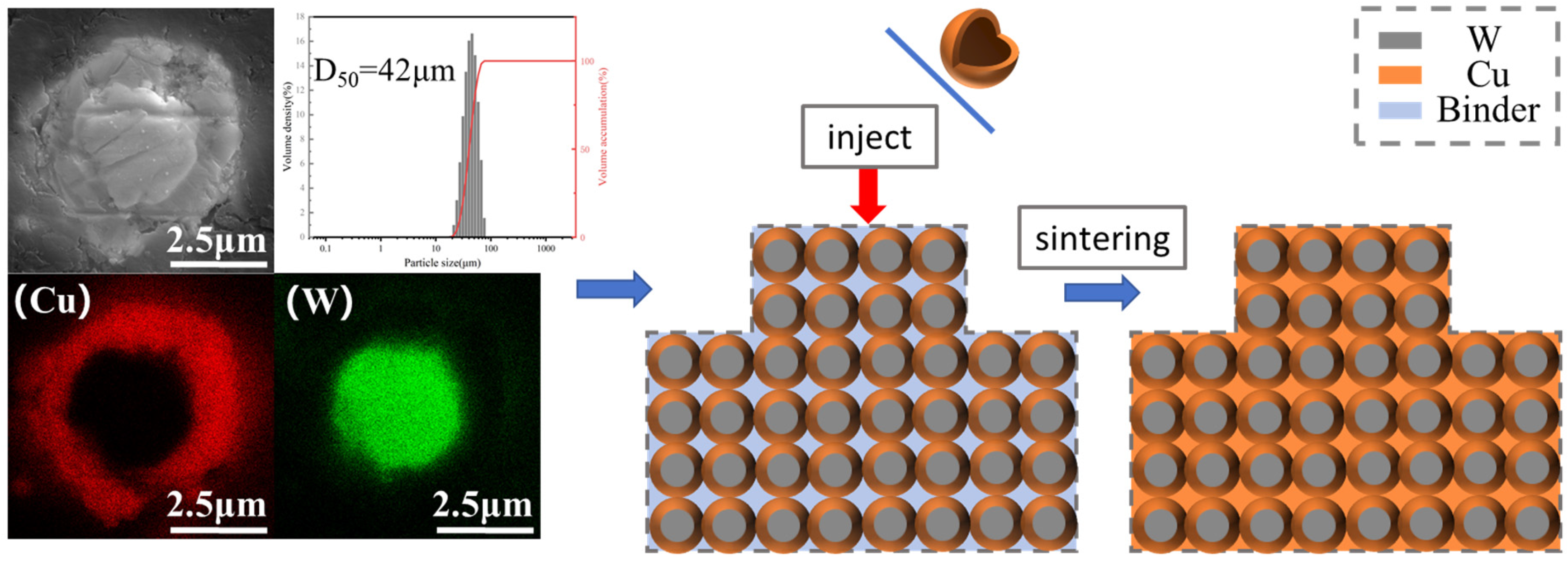
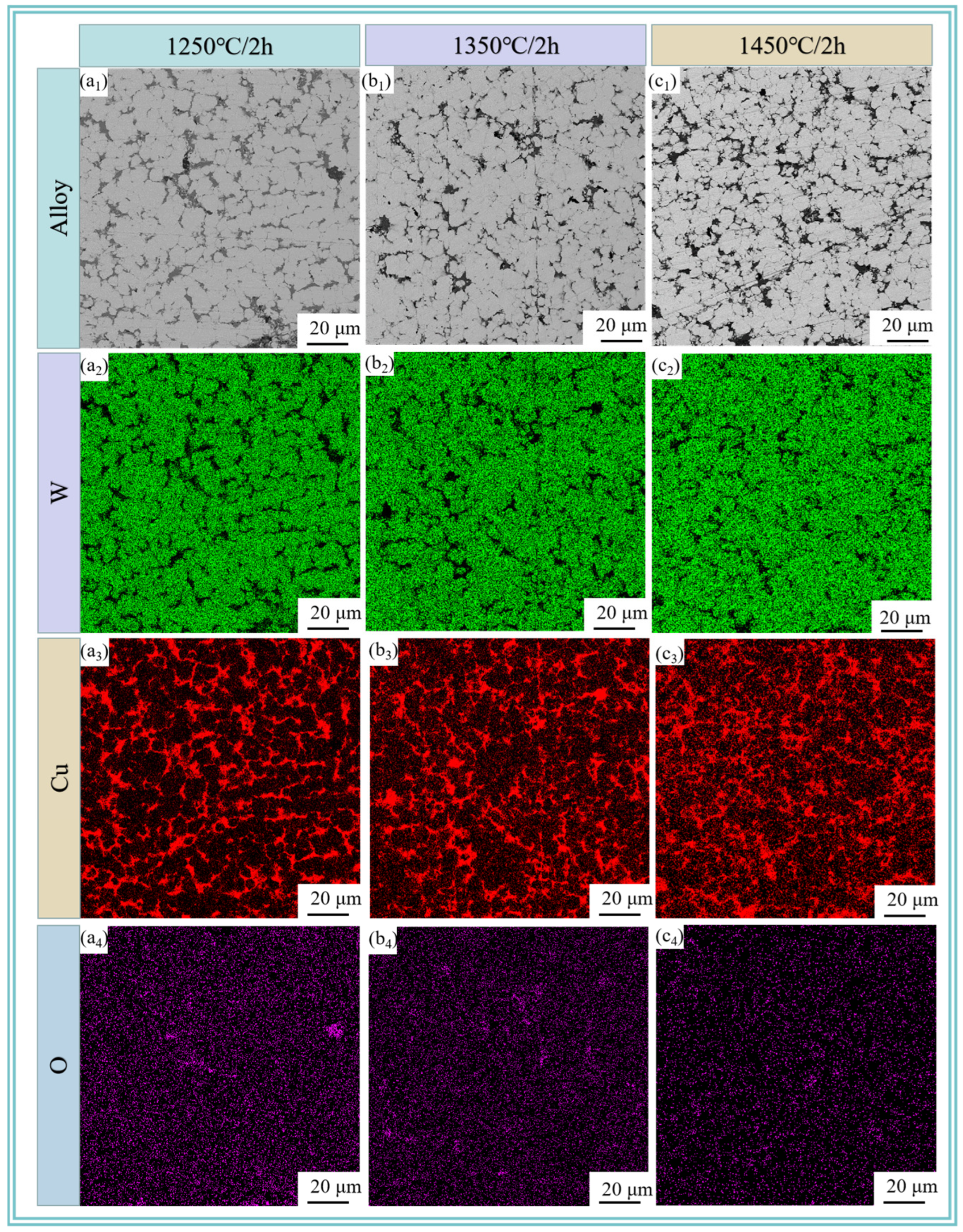

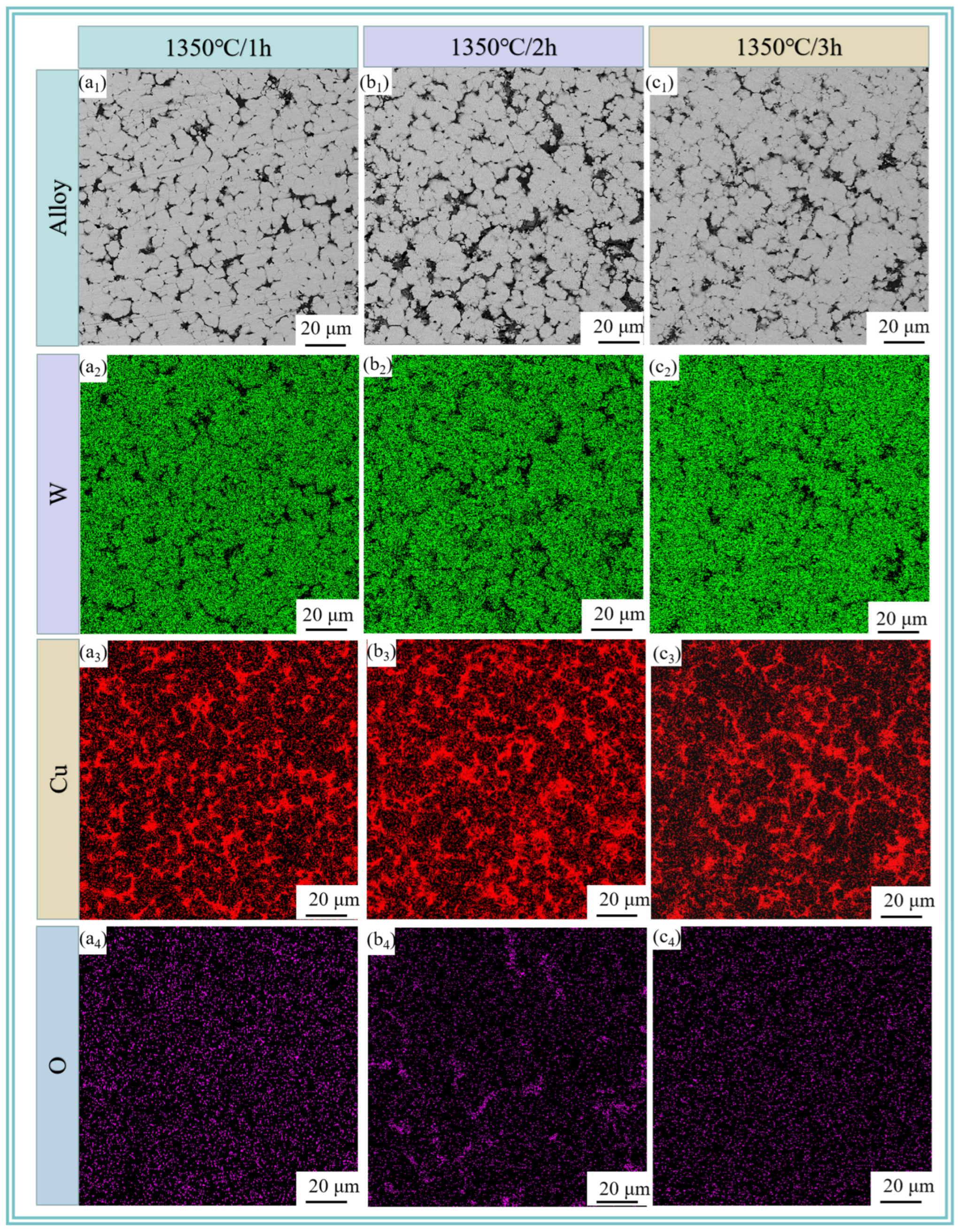
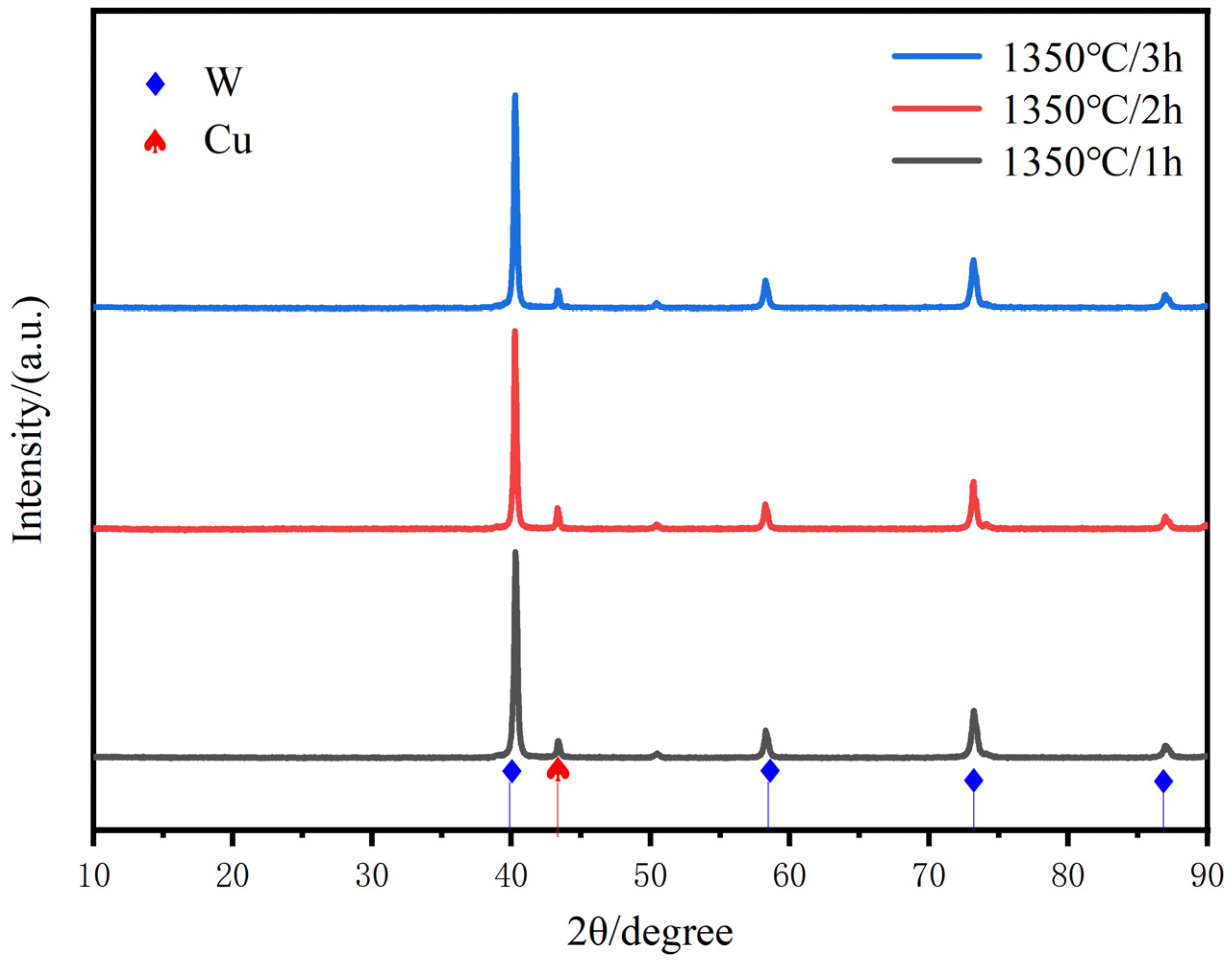
| Element | Content/wt% | Decomposing Temperature/°C |
|---|---|---|
| LDPE | 60 | 350–450 |
| PW | 30 | 234 |
| EVA | 4 | 230 |
| SA | 4 | 376 |
| BHT | 1 | 265 |
| DTD | 1 | 200–250 |
| Cementing Process | Density/% | Electrical Resistivity /μΩ·cm | Diffusivity/(mm2/s) | Conductivity/ (W/(m·K)) |
|---|---|---|---|---|
| 1250 °C/2 h | 68.30 | 22.80 | 51.64 | 109.80 |
| 1350 °C/2 h | 70.06 | 21.60 | 50.96 | 112.68 |
| 1450 °C/2 h | 74.90 | 19.84 | 50.24 | 114.23 |
| 1350 °C/1 h | 69.30 | 19.50 | 51.64 | 110.10 |
| 1350 °C/2 h | 71.20 | 18.27 | 49.93 | 112.49 |
| 1350 °C/3 h | 69.93 | 19.30 | 51.08 | 111.42 |
Disclaimer/Publisher’s Note: The statements, opinions and data contained in all publications are solely those of the individual author(s) and contributor(s) and not of MDPI and/or the editor(s). MDPI and/or the editor(s) disclaim responsibility for any injury to people or property resulting from any ideas, methods, instructions or products referred to in the content. |
© 2025 by the authors. Licensee MDPI, Basel, Switzerland. This article is an open access article distributed under the terms and conditions of the Creative Commons Attribution (CC BY) license (https://creativecommons.org/licenses/by/4.0/).
Share and Cite
Yuan, B.; Liu, W.; Wang, Z.; Li, Z.; Pan, X.; Xu, S.; Mao, S.; Wu, Y.; Li, Y.; Liu, J. 3D Printing Assisted Injection Molding of Chemically Plated W-Cu Composite. Materials 2025, 18, 1885. https://doi.org/10.3390/ma18081885
Yuan B, Liu W, Wang Z, Li Z, Pan X, Xu S, Mao S, Wu Y, Li Y, Liu J. 3D Printing Assisted Injection Molding of Chemically Plated W-Cu Composite. Materials. 2025; 18(8):1885. https://doi.org/10.3390/ma18081885
Chicago/Turabian StyleYuan, Bo, Wenwxin Liu, Zhen Wang, Zhongkai Li, Xiaofang Pan, Shurong Xu, Shoujing Mao, Ying Wu, Yangyang Li, and Jun Liu. 2025. "3D Printing Assisted Injection Molding of Chemically Plated W-Cu Composite" Materials 18, no. 8: 1885. https://doi.org/10.3390/ma18081885
APA StyleYuan, B., Liu, W., Wang, Z., Li, Z., Pan, X., Xu, S., Mao, S., Wu, Y., Li, Y., & Liu, J. (2025). 3D Printing Assisted Injection Molding of Chemically Plated W-Cu Composite. Materials, 18(8), 1885. https://doi.org/10.3390/ma18081885







